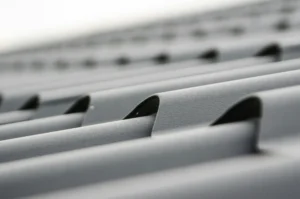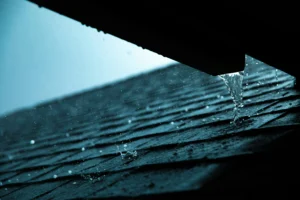One of the most important issues homeowners raise when exploring different roofing styles is whether metal roofs may attract lightning. According to the National Lightning Safety Institute, the average odds of a particular home experiencing lightning is about 1 in 200. On the contrary, many people still believe that roofs made of metal are more likely to get struck because they are good conductors. Well, if you are also confused whether it is a myth or a fact, then this guide is for you. Let us help you understand the basics of lightning and its impact on metal roofing in detail.
Table of Contents
ToggleUnderstanding Lightning
Lightning is a naturally occurring phenomenon that can be observed in a thunderstorm. It happens when electrical charge builds up either within the clouds, or in between the cloud and the ground. This electrical charge slowly creates an electric field that gets so strong that it overcomes the insulating features of air and forms a bolt of lightning. The discharge can be very strong; an electric current of lightning is usually in the range of 15,000 to 30,000 amperes and can travel as far as five miles.
Even though it is very strong, lightning follows certain rules. It usually hits the highest things such as tall trees, buildings, and utility poles. This behavior is due to the difference in electrical potential between the ground and the cloud base. Moreover, lightning tends to be attracted to conductive materials which facilitate electrical conduction.
Do Metal Roofs Attract Lightning?
The assumption that metal roofs attract lightning is an incorrect one. Whether a roof is made of metal or any other material does not increase the chance of it being hit or struck. Lightning will always be attracted to the highest point in a given area irrespective of the material used.
Factors such as height of the structure, location of the structure, and shape of the structure are more important determinants to find out where lightning will strike. In fact, metal roofs are safer when there is lightning strike as compared to other materials since metal will not catch fire, unlike wood or asphalt shingles which are combustible.
Moreover, metal roofs are capable of being part of a well designed grounding system that can isolate and disperse electrical energy to the building without damaging the building. Besides they are damage resistant and can endure extreme weathers including lightning strike better than the majority of other roofing materials.
Metal Roofs and Lightning: Myths vs. Facts
A fact that may make many homeowners fear is that metal roofs attract lightning, which is a myth. Let’s debunk some other myths as well!
Myth 1: Metal Roofs Attract Lightning
Fact: Metal roofs do not attract lightning more than any other material. A tree or isolated tall objects are likely to be hit by lightning and not a roof made out of certain material.
Myth 2: Conductivity Increases Risk
Fact: Metal materials may conduct electricity, but that does not guarantee that lightning strikes them. Conversely, metal roofs have a far lesser chance of igniting a flame, as it can at the very least carry the electrical charge of a lightning strike down into the ground unlike wood or asphalt shingles, which are both combustible.
Myth 3: Lightning Rods Attract Strikes
Fact: Metal lightning rods do not draw or attract lightning. They protect buildings by rendering lightning strikes harmless by securing them into the ground during thunderstorms. It is much better to place a lightning rod on the roofs of buildings with metal roofs for safety reasons.
Myth 4: Metal Roofs Are Not Safe If Used During Storms.
Fact: Metal roofs do not catch fire when lightning strikes making them safer during thunderstorms than traditional roofs. Moreover, metal roofs help to minimize the damage by spreading the electrical energy over a wider area.
Myth 5: Proper Grounding Is Not Important
Fact: Grounding is quite vital for every structure, even for buildings with metal roofs. A lightning protection system (LPS) can safely channel the lightning into the earth and in conjunction with the metal roof minimizes the likelihood of damage.
The Reality of Conductivity and Lightning
- Conductivity: During a lightning strike, metal roofs are able to limit the energy during the strike as it is spread over the entire structure. This means when electricity radiates over the metal roof, it is more evenly distributed across the surface which helps to reduce damage to the structure.
- Fire Resistance: Metal roofs are non-flammable unlike most other materials and therefore are less likely to set on fire due to a lightning strike. This reduces damage to the building and is safe for the people who are inside.
- Facilitating Safety: Metal roofs may serve to enhance the effectiveness of a lightning protective system. They may act with lightning rods and conductors reducing further any risk to the building structure.
Advantages of Metal Roofs in Thunderstorms
Metal roofs are not only known for their durability but also offer several benefits during a thunderstorm. The non-combustible feature of metal roofs significantly reduces chances of catching fire from lightning. This feature provides a better safety margin when compared to other materials such as wood shingles which have low resistance to fire.
Moreover, the slick surface of metal roofs sheds water effectively, preventing accumulation of water which may cause structural damage. These strong roofs tend to be hail-resistant, reducing the potential for damage during severe weather.
Metal Roofing Safety Considerations
While metal roofs have amazing capabilities when it comes to protecting against storms, it is still very important to consider the safety precautions needed before installing and maintaining them.
Safety Standards For Metal Roof Installation
The protective features of a metal roof are maximized only after it is properly and professionally installed. During installations, safety standards and building codes are upheld to increase the structural integrity of the roof. The Metal Roofing Alliance is one of those agencies whose guidance is generally followed by the roofers during the installation to achieve a safe durable roof system. Proper fasteners are used and mixing different types of metals, such as aluminum with steel is avoided to limit corrosion and degradation of the roof over time.
The Importance Of Grounding In Lightning Protection
It must be noted that while metal roofs do not increase the chances of being hit by lightning, appropriate grounding does enable the safe flow of electricity during a lightning strike and minimizes the risk of electric fires. Grounding also decreases the chances of damage during lightning strikes. Providing comprehensive lightning protection systems along with grounding protects not only the home but its electric wiring as well, preventing any possible power surges. For homes to be completely secure from lightning strikes, it is essential that qualified experts are consulted for the installation and maintenance of lightning protection systems.
Insurance and Safety Ratings Achievement:
Taking into account the security and sturdiness of a home, metal roofs can drastically reduce the amount an insurance company has to charge. First of all, metal roofs are rated exceptionally high both for their resistance to fire and impact. Due to this fact, the potential loss after fires or severe storms is much lower. Consequently, insurance firms tend to charge less for homes with metal roofs as a result of their proven effectiveness in adverse conditions. It is required that homeowners check the safety ratings and certifications of the roofing materials prior to their installation in order to protect them. Because this not only safeguards the property, but also allows one to save money by paying lower insurance premiums.
Conclusion
To summarize, the common perception that “lightning is attracted to metal roofs” is not true. Geographic and weather conditions determine how frequently lightning may strike, instead of not the type of roof that was installed. In the event of a lightning strike metal roofs are better as they spread the energy of the strike and minimize the risk of fire. They also withstand extreme weather and provide long term protection. While selecting a roof, it is crucial to consider the facts and be aware that metal roofs are both safe and long-lasting without the threat of being struck by lightning.
FAQs
Does installing a metal roof increase the risk of a lightning strike?
No, installing a metal roof will not increase the likelihood of your house getting struck by lightning. Inherently, metal roofs are no more attractive to lightning when compared to other roofing materials. Height of the building, its location, and structures surrounding it have more to do with the possibility of being struck by lightning.
What makes metal roofing safe during a lightning storm?
Yes! Metal roofs are safe to use in thunderstorms due to the fact that metal is a material that never burns, which allows it to spread the energy from a thunder strike preventing any risk of fires or damage to the buildings structural integrity, as well as having a proper grounding system in place which lets the current flow safely and effectively into the ground.
Will having a metal roof make it easy for my house to be struck by lightning?
One thing is for sure a metal roof will not increase your likelihood of getting struck by lightning, in fact, having metal enhances your odds of being struck by lightning metal will transfer the electrical charge of the lightning away, thus lowering the damage possible.
Which metals are the most effective in protecting against lightning?
When it comes to shielding against lightning, Copper and its alloys, including bronze and brass are some of the most suitable metals available. These metals are incredibly conductive, enabling them to effectively carry electrical charges from lightning strikes safely to the ground. Because of their strength and ability to resist corrosion, they are suitable for use in lightning rod and grounding systems.







